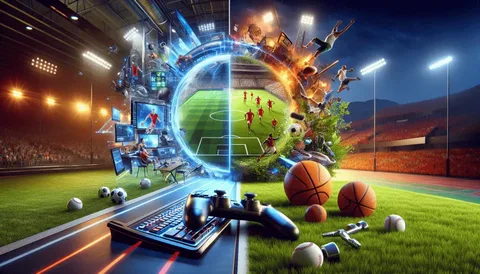Games have existed since the dawn of civilization. From ancient strategy games etched on stone to today’s high-definition virtual worlds, games have always reflected the way humans learn, compete, relax, and connect. Whether it’s a child playing hide-and-seek in a backyard, a teenager mastering a new level in a video game, or adults gathering around a board game table, the concept of play is as old as humanity itself.
But in the 21st century, games have evolved into something far more influential than mere entertainment. They have become tools for education, engines for social connection, and platforms for creativity. The world of games is no longer divided between playgrounds and screens—it is a dynamic, interwoven universe that touches every aspect of life. Let’s explore this fascinating world, its benefits and drawbacks, and what role games should play in our modern lives.
The Physical Game:
-
The Return of Traditional Play
Before consoles and mobile apps dominated free time, physical games were the primary form of recreation. From tag and dodgeball to hopscotch, soccer, and chess, these games weren’t just time-fillers—they were life lessons in motion. Physical games encourage teamwork, strategic thinking, coordination, and endurance. They help children develop motor skills and teach values like fairness, patience, and sportsmanship.
In recent years, physical play has seen a revival, especially with the rise of organized sports, fitness-focused games, and even nostalgia-driven adult leagues. There’s something timeless about real-world play that digital experiences can’t replicate: the high-five after a hard-earned point, the sting of a missed goal, the raw emotion of competition.
-
Advantages of Physical Games
Physical games come with a host of benefits. They promote physical health, strengthen social bonds, and improve mental well-being by reducing stress. These games often require face-to-face interaction, which builds empathy and communication skills—critical abilities in an increasingly digital world.
Moreover, physical games are inclusive by design. They often transcend language, culture, and technology, making them accessible to people of all ages and backgrounds.
-
Disadvantages of Physical Games
However, they are not without limitations. Physical games require space, time, and sometimes equipment or supervision. In urban settings, children may not have safe access to outdoor play areas. Additionally, physical limitations or disabilities can restrict participation for some individuals, highlighting the need for inclusive design and adaptive games.
The Digital Game:
-
The Rise of Virtual Playgrounds
Digital games have exploded into a multibillion-dollar global industry. From mobile puzzle apps and battle royales to story-rich RPGs and immersive virtual reality, digital games are diverse, compelling, and ever-evolving. They have become a defining cultural force for multiple generations.
These games allow players to step into roles they could never assume in real life—to be heroes, strategists, creators, and explorers. Online games connect players from different continents, building friendships and communities that extend beyond the game itself.
-
Advantages of Digital Games
The benefits of digital gaming are broad. They sharpen cognitive abilities, improve reflexes, and enhance decision-making skills. Many games encourage collaboration and strategic planning. Educational games make learning fun and interactive, helping children grasp difficult subjects through play.
Moreover, for individuals with physical disabilities or social anxiety, digital games offer a safe and inclusive environment where participation is unhindered by real-world barriers. Games like Minecraft, for instance, inspire creativity and problem-solving, while others promote awareness of historical events or social issues through interactive storytelling.
-
Disadvantages of Digital Games
Yet, digital games come with their own set of challenges. Excessive screen time can lead to health problems such as eye strain, sedentary lifestyle, and sleep disturbances. Some games may contain violent or addictive elements, influencing young minds in ways that are not always positive.
There’s also the issue of social isolation. While online gaming fosters virtual connections, it can sometimes replace real-world interaction, leading to loneliness or even a sense of detachment from reality. Parental guidance and mindful play are crucial to maintaining a healthy balance.
Choosing the Right Games:
-
Aligning Games with Purpose
Not all games are created equal. The best games are those that align with your goals, values, and context. For young children, games that build motor skills and promote creativity are ideal. For teens and adults, strategy games, sports, and cooperative digital platforms can provide intellectual stimulation, social engagement, and emotional resilience.
Games should challenge players without overwhelming them. They should offer opportunities for growth, reflection, and enjoyment. Whether it’s a board game that makes your family laugh or an online quest that helps you unwind after work, the right game is the one that enhances your life rather than distracting you from it.
-
The Importance of Balance and Moderation
Both physical and digital games have immense value, but balance is key. A healthy gaming routine should incorporate movement, social interaction, learning, and relaxation. It’s okay to enjoy a few hours of digital gaming—especially if it’s enriching or social—but it should be balanced with physical activity and offline relationships.
Parents, educators, and even gamers themselves must be conscious of time spent and content consumed. Setting boundaries, taking breaks, and choosing high-quality games can make all the difference.
The Importance of Games in Human Development:
Games are not just a break from learning—they are often the best form of it. Children develop language, logic, and empathy through games. Adults improve memory, stress management, and focus. Seniors use games to maintain cognitive health and social ties. Games are particularly powerful in education and therapy. In classrooms, game-based learning keeps students engaged and improves retention. In healthcare, gamified therapy helps patients recover skills after injuries or cope with mental health challenges.
Games often mirror real-life challenges. They teach us how to win with humility and lose with grace. They simulate difficult decisions, moral dilemmas, and team dynamics, offering safe spaces to experiment and grow. Cooperative games foster trust and collaboration, while competitive ones can build confidence and resilience. Games also help bridge generational and cultural gaps. A grandparent and grandchild playing chess, or strangers bonding over a multiplayer battle, demonstrate how games can unite people across divides.
Conclusion:
In an age where the line between physical and digital grows increasingly blurred, the world of games stands as a testament to humanity’s enduring need for creativity, connection, and challenge. Whether on a court, a console, or a phone, the spirit of play continues to shape who we are and who we can become.
Games are not just about fun—they are about learning, healing, building, and belonging. Choosing the right games, maintaining balance, and embracing their diverse benefits can enrich our lives in profound ways.
So pick up that controller, lace up those shoes, shuffle that deck, or download that app—because in every game, there’s an opportunity to level up not just your skills, but your life.




